|
Frank Lloyd Wright's Legacy in San Diego
By Keith York
Over the years many San Diegans have presumed that Frank Lloyd Wright built a house in their neighborhood, or along their drive to the office or local grocer. While many structures across the county exhibit Wrightian qualities, no Frank Lloyd Wright designed structures exist in San Diego county1.
What does exist is the work of a handful of Frank Lloyd Wright scholars, as well as former colleagues and friends of Mr. Wright. Of particular interest are his sons' local designs and the very few San Diegans that worked under Wright in his Taliesin Fellowship program. Beyond those with intimate connections to Wright, his influential buildings and philosophy have influenced local architects since his passing in 1959. San Diego, like many cities, should hold dear the Wrightian legacy that remains part of the local landscape and history to this day.
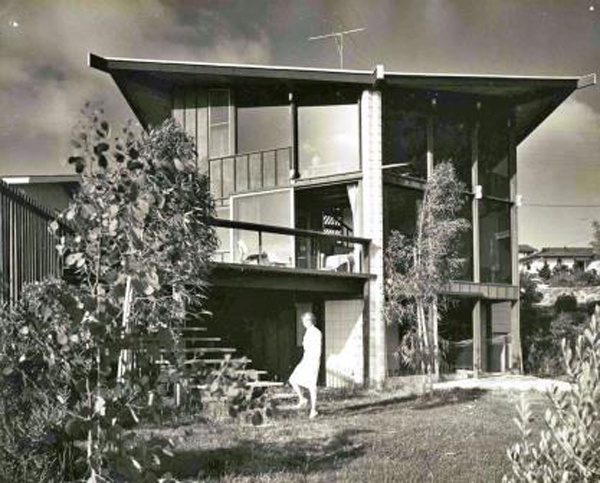 Loch and Claire Crane Residence, La Jolla, 1962
|
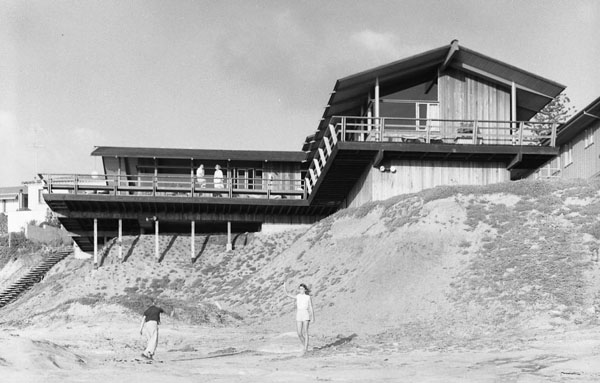 Louis Liebhardt Residence in La Jolla. Designed by Frederick Leibhardt, 1958. Photo by Douglas Simmaonds.
|
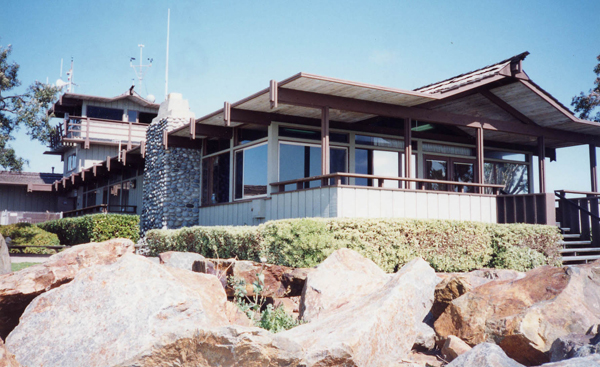 Mission Bay Aquatic Control Center, designed by Sim Bruce Richards, 1960.
|
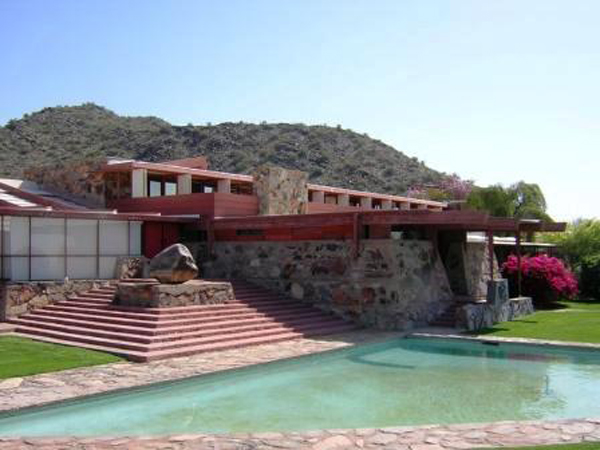 Taliesin West was architect Frank Lloyd Wright's winter home and school in the desert in Scottsdale, Arizona, from 1937 until his death in 1959 at the age of 91.
|
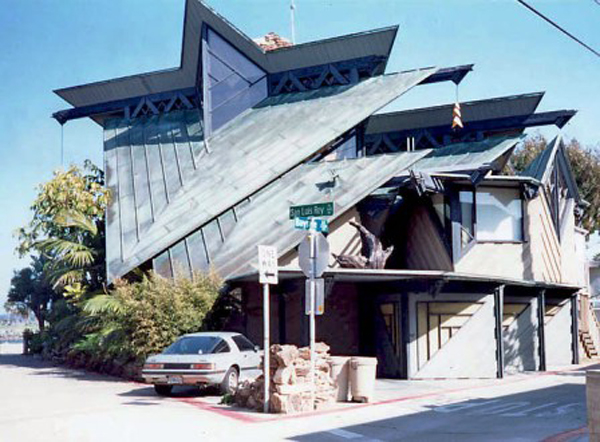 Russell Babcock Residence in Mission Beach. Designed by Kendrick Bangs Kellogg, 1959.
|
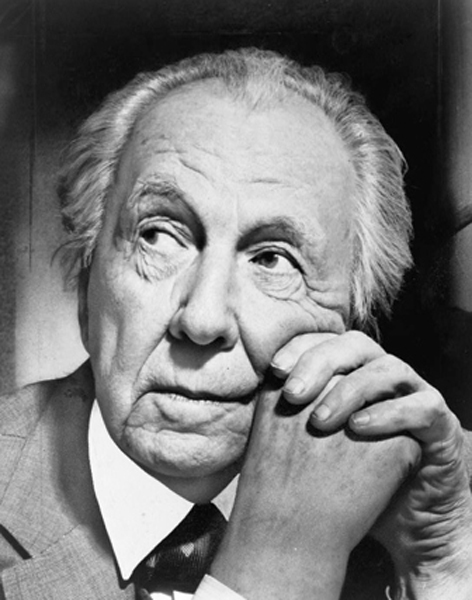 Frank Lloyd Wright, 1923
|
Beyond Frank Lloyd Wright's stay on Coast Boulevard in La Jolla and his 19282 wedding to Olgivanna Wright in Rancho Santa Fe, he primarily came to California to visit his projects, clients and sons: Los Angeles architect Lloyd Wright and Del Mar building designer John Lloyd Wright3,4. Between such visits, his former apprentices practicing in San Diego, including Loch Crane, Frederick Liebhardt, Sim Bruce Richards and Vincent Bonini, would visit him at Taliesin West and exchange letters with their teacher and mentor3,5.
According to Byron Cunningham, Frank Lloyd Wright did design three projects for San Diego clients, though all of them went unbuilt for various reasons. Wright's first project for the area was the Cinema for San Diego (1905)1. His second project, Schoolhouse for Negro Children for the Rosenwald Foundation (1929), followed Rosenwald's 1928 commission for a school in Hampton, Virginia. Though Frank Lloyd Wright did not sign the blueprints, his last project attribution in San Diego, the Harvey Furgatch Residence, was planned for construction in Spring Valley in 19596. Signed on behalf of Taliesin Associated Architects by Aaron Green, the Furgatch design was based heavily on Wright's Jester Residence (1938), which was actually built as the Norman Lykes Residence that same year in Phoenix (after the design was shopped around to several clients beyond Furgatch)4,6,7. Furgatch would ultimately hire Wright Fellow Sim Bruce Richards to build a home on the oceanfront in Del Mar4.
Two of Frank Lloyd Wright's sons, Lloyd and John Lloyd, contributed to San Diego's Wrightian legacy. Though Lloyd Wright designed several buildings in California under the influence of his father, only two commissions were in San Diego. Both of Wright's sons initially came to San Diego for work with Olmstead Brothers, the landscape architects for the Panama-Pacific Exposition8. Following this work and a few design jobs, Lloyd moved to Los Angeles where he would spend the rest of his fruitful career and life, and John returned to Illinois (only to return to Del Mar decades later).
From his Los Angeles studio, Lloyd Wright designed two projects in San Diego, neither of which was constructed. The first project, the Russell Babcock Residence (1953)9, went unbuilt on its projected lot on Mission Cliffs Drive in University Heights. According to Lloyd's son Eric Lloyd Wright, Russell Babcock went to Frank Lloyd Wright in the early 1950s but ended up working with Lloyd instead10. Soon after the project failed to be realized, Babcock hired a young Mission Beach architect by the name of Kendrick Bangs Kellogg to realize his Wrightian dream home on Mission Bay (built as the Babcock Residence of 1959)4. More than a decade later (in 1964), Lloyd was commissioned to design University Housing for U.C. San Diego, which also went unbuilt9.
Born in 1892, John Lloyd Wright put his architectural stamp on two cities - Long Beach, Indiana (where he worked between 1920-1946) and San Diego (between 1910-1913 and again from 1946 until his death in 1972)8.
Following his short stint with brother Lloyd at Olmstead Brothers, John worked for Pacific Building Company (2906 Beech Street is attributed to this work), then architect Harrison Albright11. At age 20, in 1912, John was given two commissions by Albright - the Mrs. M.J. Wood House in Escondido, and Workingman's (Golden West) Hotel.8 While in San Diego, Wright also worked on at least three projects for Irving Gill's office (O'Kelly Residence, Alice Lee Cottage on Albatross Street, and Marian Olmsted Residence)12. Returning to Del Mar in 1946, John would design nearly four dozen projects across the county, many of which were in Del Mar, La Jolla and Rancho Santa Fe8. Much like his father, John clashed with San Diego officials over calling himself an architect while not licensed in California. Like his father, John took the debate to the press, clashing with C.J. Paderewski about the legitimacy of such trivial matters.13 John (who authored the book My Father Who is on Earth, 1946; and invented Lincoln Logs) would arrive a building designer and leave as a highly honored architect. John passed his own and his father's philosophy to more homeowners than employees - employing very few men in his office: Herb Turner between 1950-52 and Stuart Resor in the late 1960s14.
Beyond his son John's built projects, Frank Lloyd Wright's legacy in San Diego is seen through his impact on the designs of his early Taliesin Fellowship colleagues, many of which are still visible. Sim Bruce Richards, Loch Crane, Frederick Liebhardt and Vincent Bonini worked directly for Frank Lloyd Wright as Taliesin Fellows, and then settled in San Diego to practice architecture.
Sim Bruce Richards was discovered by Frank Lloyd Wright through his early abstract rug designs while attending UC Berkeley (1930-34)15. Upon an invitation from Mr. Wright, impressed by Bruce's early work, Richards worked directly for Wright in the Taliesin Fellowship between 1934-3516. Bruce moved to San Diego in 1938 and drafted for the 11th Naval District and later William Templeton Johnson15. Following a brief stint with architect Harold Abrams (1946)15, Bruce began a multi-decade career designing some of the finest hand-crafted residences that followed Wright's principles of organic architecture [Among them: Siting a project in the manner the site dictated; using organic and even native materials to the site and surrounding areas; and incorporating plenty of natural light with a project designed at a "human" scale].
Loch Crane's introduction to Wright took a different path. Mrs. Crane showed her son the January 17, 1938 issue of Time Magazine, featuring Frank Lloyd Wright on the cover as "the greatest American architect of all time"5. As a young Crane looked at the magazine, his mother said, "this is who you will go work for." He and his mother packed up her Model A Ford and drove to Taliesin West outside of Scottsdale. They arrived in Arizona in early March 1941 - Mrs. Crane brandishing a $1000 check for the fellowship tuition, and the younger Crane armed with completed drawings from William Templeton Johnson's office5.
Loch Crane lived and worked with the Taliesin Fellows (1941-42) until his duty to country led him to enlist in the U.S. Army Air Corps. Following World War II, Loch Crane returned to San Diego in late 1946 to his wife Claire5. By 1948, he built his first "expandable house" on Udall Street in Point Loma - testing the concept for his own family. This concept house was to be built in stages - expanding as one's family grew (a topic he began wrestling with while at Taliesin)5. Throughout his career, Loch adapted Wright's hexagonal forms in many of his building projects.
Following the War, Frederick Liebhardt was accepted at USC and at the University of Denver. With this optimism, Fred wrote Frank Lloyd Wright asking to work at Taliesin3. He was turned down. In 1945, while at the University of Denver, Fred attended a lecture by Frank Lloyd Wright. After Fred's instructor showed Mr. Wright his drawings, he asked Fred and his wife Marianne to visit him at Taliesin. According to her, Wright wrote, "Come be with me before they [University of Denver faculty] ruin you."
In 1947 Fred and Marianne left Colorado to join the Taliesin Fellowship where Fred acquired the architectural orientation that he pursued throughout his career. The Liebhardts were at Taliesin (Spring Green, WI) and Taliesin West (Scottsdale, AZ) between 1948-493. In an unusual move, Mr. Wright sent Fred straight to the drafting room rather than the norm of employing apprentices in less-distinguished roles early in their education3.
According to Marianne Liebhardt, over the years Frank Lloyd Wright regretted only a few of his apprentices leaving his employ - Rowan Maiden (known for his Nepenthe Restaurant in Big Sur), John Lautner, and Fred Liebhardt (blaming wife Marianne for his departure)3. Fred and Marianne, through the Taliesin Fellowship, would become friends with many other apprentices and family including then Del Mar resident John Lloyd Wright. The Liebhardts continued to visit Frank Lloyd Wright through the 1950s until his death3.
According to Maryann Bonini, Vincent Bonini attended Taliesin (both East and West) during 1947 and 194818. Living in La Canada (and making friends with another architect soon-to-migrate to San Diego, Eugene Weston III) and working for Smith & Williams and Harwell Hamilton Harris19, Vincent Bonini scored some early recognition when the house he designed for his own family was widely published by Julius Shulman20. Upon arriving in La Jolla in 1959, Vincent built a spec house near Fred Liebhardt and Eugene Weston's own spec house projects19. Soon after, Bonini gave up on private practice, sold the spec house, moved into Fred Liebhardt's Carrizo Drive residence and joined up with his firm Liebhardt & Weston19. A few years later, Bonini would make his impact on San Diego in the architecture and engineering office at UCSD where he would stay until retirement.
One of the most startling examples of Wright's influence on a San Diego architect may be Mission Beach native Kendrick Bangs Kellogg. Ken first met Mr. Wright in 1955 while attending the University of Colorado at Boulder. Of this instance, Ken recently recollected, "In April 1955, I... visited Phoenix with a few students from my architecture class... and I met [Frank Lloyd Wright] and heard him speak to a group... of us architects... and had an interview with him4."
Kellogg returned to San Diego and, among other things, worked for Sim Bruce Richards for two summers and spent time with John Lloyd Wright4. Kellogg's organic architecture would be first published when he completed the Russell Babcock Residence (1959), after engaging Lloyd Wright's client for his earlier failed commission in University Heights4. At this time Ken would begin a multi-decade working relationship with metalworker Bill Slatton, who worked under the direct supervision of Frank Lloyd Wright at Taliesin between 1956-594. Slatton's organic designs can be evidenced in a number of Kellogg's early residential projects.
Many other San Diego architects have been influenced by Wright's presence, his philosophy, writings, teachings, and buildings or a combination thereof. Though he never built a structure in San Diego county, our local architectural heritage is, in part, influenced by the work of his progeny, his teachings and philosophy.
References
1Frank Lloyd Wright: An Association with San Diego by Bryon G. Cunningham, San Diego Union Tribune, 1985
2For an image of the wedding announcement: https://www.arslibri.com/cat130w34.htm
3Marianne Liebhardt Interview 3/3/05
4Kendrick Bangs Kellogg email interviews 8/18-8/21/05
5Loch Crane Interview 8/27/05
6Furgatch Residence drawings are on view in the San Diego Historical Society archives
7https://www.doney.net/aroundaz/celebrity/wright_franklloyd.htm
8Ann Van Zanten, John Lloyd Wright, Architecture & Design, 1982
9Lloyd Wright Architect, David Gebhard & Harriette Von Breton (1971)
10According to Eric Lloyd Wright (in A Legacy Rediscovered 11/13/82 Union Tribune article by January Riddle), Russell Babcock solicited Frank Lloyd Wright in the early 1950s but went with Lloyd Wright instead.
11Kathy Flanigan, miscellaneous (and not filed) notes by in San Diego Historical Society archives
12Erik Hanson email interview 12/17/05
13James Britton, "The Son of the Father Who is on Earth", San Diego & Point, Summer 1954
14Herb Turner Interviews (3/03, 9/04)
15Janet Richards Interview 3/22/02
16Randolph C. Henning, At Taliesin, (1992), p.314
17Sim Bruce Richards San Diego Historical Society Oral History (1982)
18Maryann Bonini interview 1/4/06
19Eugene Weston email interview 12/16/05
20Pierluigi Serraino, Julius Shulman, Modernism Rediscovered, 2000 pp163-164
|
MORE FROM THIS ISSUE
Without Our Members
How Will Our Children Know?
Preservation Begins at Home
City of Encinitas Approved its First Historic Landmark & Mills Act Contract
Announcing SOHO Historical Tours A Year Round Program
Encinitas Loses a Landmark
Frank Lloyd Wright's Legacy in San Diego
2006 Resource Directory (Opens pdf in separate window)
In Memoriam: Al Alferos
SOHO Extends Appreciation
La Pastorela at the Old Adobe Chapel
Interrobang
Because We Need You Now More Than Ever
If You Care About San Diego, Ask a Friend to Join SOHO!
SOHO Membership Survey (Opens pdf in separate window)
Strength in Numbers
Lost San Diego
DOWNLOAD full magazine as pdf (8.4mb)
|









